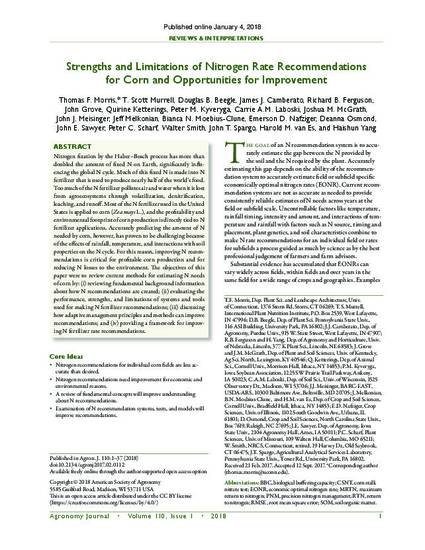
Nitrogen fixation by the Haber–Bosch process has more than doubled the amount of fixed N on Earth, significantly influencing the global N cycle. Much of this fixed N is made into N fertilizer that is used to produce nearly half of the world’s food. Too much of the N fertilizer pollutes air and water when it is lost from agroecosystems through volatilization, denitrification, leaching, and runoff. Most of the N fertilizer used in the United States is applied to corn (Zea mays L.), and the profitability and environmental footprint of corn production is directly tied to N fertilizer applications. Accurately predicting the amount of N needed by corn, however, has proven to be challenging because of the effects of rainfall, temperature, and interactions with soil properties on the N cycle. For this reason, improving N recommendations is critical for profitable corn production and for reducing N losses to the environment. The objectives of this paper were to review current methods for estimating N needs of corn by: (i) reviewing fundamental background information about how N recommendations are created; (ii) evaluating the performance, strengths, and limitations of systems and tools used for making N fertilizer recommendations; (iii) discussing how adaptive management principles and methods can improve recommendations; and (iv) providing a framework for improving N fertilizer rate recommendations.
Available at: http://works.bepress.com/john-sawyer/398/

This article is published as Morris, T. F., T. S. Murrell, D. B. Beegle, J. J. Camberato, R. B. Ferguson, J. Grove, Q. Ketterings, P. M. Kyveryga, C. A.M. Laboski, J. M. McGrath, J. J. Meisinger, J. Melkonian, B. N. Moebius-Clune, E. D. Nafziger, D. Osmond, J. E. Sawyer, P. C. Scharf, W. Smith, J. T. Spargo, H. M. van Es, and H. Yang. 2018. Strengths and Limitations of Nitrogen Rate Recommendations for Corn and Opportunities for Improvement. Agron. J. 110:1-37. doi: 10.2134/agronj2017.02.0112.